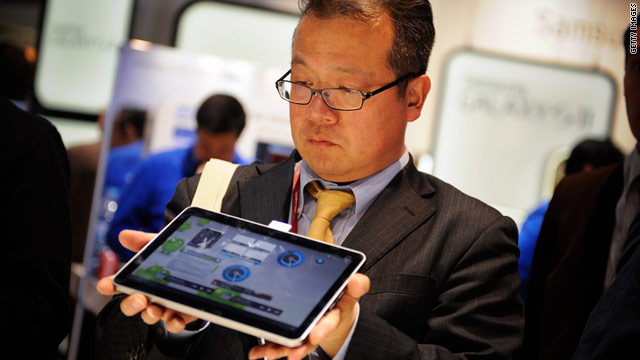Widescreen(16:9/16:10) tablets are coming soon

Hardware manufacturers bent on stealing customers away from Apple are designing their tablet computers with the movie watcher in mind.
An onslaught of new tablets are adopting a widescreen format instead of mimicking the iPad's display, which is shaped more like a standard sheet of office paper.
Shipments of tablets are expected to increase by 200% over last year, according to a report by research firm DisplaySearch. And tablets with wide screens are flooding supply chains, the report says.
Several companies showed off upcoming slates this week at Mobile World Congress, a massive mobile-tech conference in Barcelona, Spain. Three Android tablets from ViewSonic, Huawei and SmartQ vary in size but have widescreen dimensions in common.
Another trio of devices run Google's tablet-optimized operating system, called Honeycomb, and feature a similar film-friendly display. One such product, the Galaxy Tab 10.1, was announced by Samsung Electronics at the Barcelona show. Samsung describes the device as the "ultimate entertainer," with "full HD movies" listed as the top selling point on its promotional website.
Samsung's current tablets also have wide screens. In fact, those smaller devices very nearly adhere to a 16:9 aspect ratio, which is the format most movies are produced in. The Honeycomb tablets, with their 10-inch screens, are 16:10 in size and will need thin black bars to display the whole picture.
The iPad, meanwhile, has a 4:3 ratio. That's the same as what tube-screen TVs used until the recent switch to wider HD programming.
Those three types of screens -- the 9.7-inch one used by the iPad, as well as the 7- and 10-inch widescreens used by other tablets -- are expected to be the "dominant screen sizes," DisplaySearch said. (Anything larger than 10 inches in a widescreen format would be "hard to pull off," said Carolina Milanesi, an analyst for research firm Gartner.)
Considering that consumers shifted en masse to widescreen TVs over the last decade, some considered it surprising that, for Apple's forward-thinking tablet, the company chose the screen format that it did.
Watching movies and recent TV series on an iPad can be frustrating because users have to choose between large black bars on the top and bottom of the screen or cutting off a portion of the sides of the video.
"When Apple introduced its iPad in 2010, it once again shocked many industry observers by providing a standard (4:3) aspect ratio device, even as notebooks, monitors and TVs were moving to wide (16:9 or 16:10) formats," DisplaySearch wrote in its report. "The success of the iPad has sparked debates about the best display format for slates."
But the iPad's sheet-of-paper-like dimensions are useful for certain tasks.
"Applications such as e-mail and gaming work well with the current 4:3 aspect ratio," Dan Hays, a director at management consulting firm PRTM, wrote in an e-mail. "The question for manufacturers is how customers will use tablets once they are mainstream."
Hays' colleague, Huw Andrews, says consumers don't seem put off by the iPad's suboptimal format for showing movies. And that's certainly evident by the 15 million units Apple sold last year.
"At these larger screen sizes, watching widescreen video is a good user experience, even though it does not fill the entire screen," Andrews wrote.
Hewlett-Packard announced a tablet called the TouchPad last week. Like Apple's, HP's tablet runs a proprietary operating system, and it has the same screen dimensions and resolution of the iPad.
But other much-hyped tablets, like the BlackBerry PlayBook from Research in Motion and LG's G-Slate, have wide screens. Motorola Mobility's premiere Android Honeycomb tablet, the Xoom, also has a wide screen that's "optimized for high definition video in true 16:9 widescreen format," the company said.
(CNN)